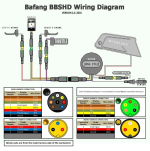Note: The wiring diagram above is for the
MALE pin connector/controller side. The
FEMALE side, or throttle side of the connector looks like the top one shown in the pic below. This shows that the pins are reversed on either side of the notch because of how they are connected and mirrored...
To be
absolutely sure... things are going to where they need to be. Open the throttle and measure voltages
at the hall sensors' legs... correct designations are shown in next pic...
I'd recommend doing the voltage checks with the signal output disconnected from the vesc.

See that the magnet(s) are in the correct position. (May be one or two...) And verify that the battery's ground is getting all the way to the middle leg.
A bad ground will cause the hall signal output to stick wide open.
With the hall sensor removed from any magnetic gauss, the voltage output signal will be half the input voltage.
If needed, It should work just as well with the lower 3.3vdc supply. With the output being reduced by ~ .6vdc
For more information on hall sensor throttles, including different output voltage results at lower input voltages, paw thru this thread...
Guide to Hall Sensor Throttle operation, testing, and modification.
Fingers crossed that it's not toast yet.
Regards,
T.C.




